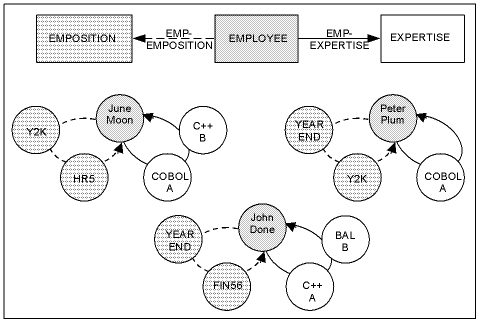

One record type can own more than one set reflecting the fact that an entity can be the owner in multiple 1-to-n relationships. For example, the EMPLOYEE record type at Commonweather Corporation owns the EMP-EXPERTISE set identifying the skills held by a given employee and the EMP-EMPOSITION set to keep track of the various projects to which the employee is assigned. The following figure illustrates this example of multiple ownership: occurrences of the EMP-EXPERTISE set and the EMP-EMPOSITION set are shown with both set occurrences owned by the June Moon record occurrence.

Multiple set ownership logically unites the member records of two (or more) types while maintaining discrete linkages and orders. The common owner record provides the means of movement between the different member records. For example, using the following diagram, if we are trying to locate employees on the Y2K project that have at least a B proficiency in C++, we could satisfy this query by asking the following questions:
Question: For each EXPERTISE that indicates a B proficiency in C++, what record is the owner in the EMP-EXPERTISE set?
Answer: The June Moon and John Done record occurrences.
Question: What are the members of the EMP-EMPOSITION set that June Moon owns? That John Done owns?
Answer: June Moon: Y2K, HR5. John Done: YEAR END, FIN56.

|
Copyright © 2013 CA.
All rights reserved.
|
|